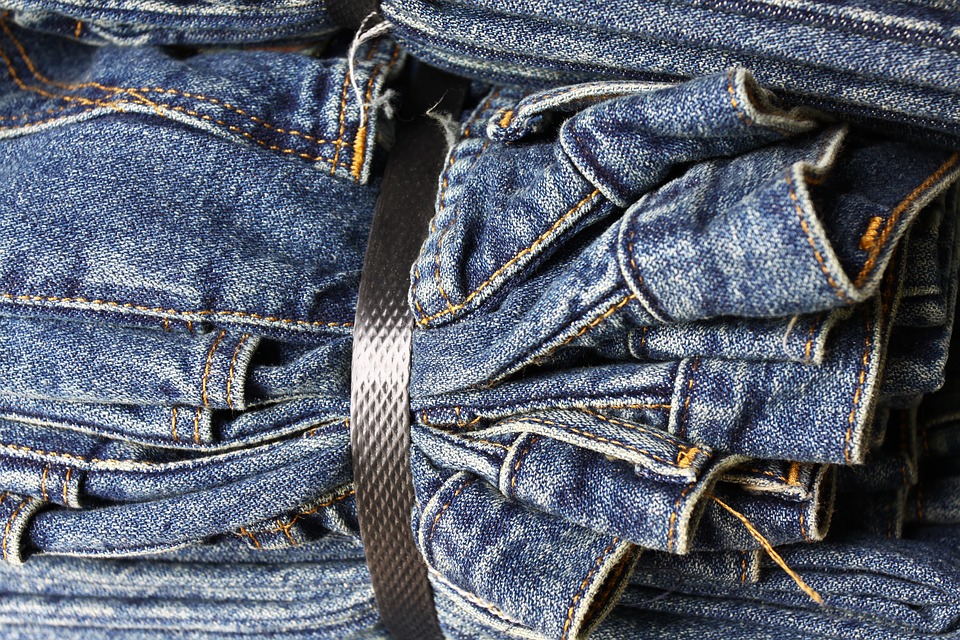No other fabric compares to the versatility of denim. This durable cotton twill textile offers the perfect blend of style, comfort, strength and durability. Whether it’s a pair of jeans or a denim jacket, you can’t go wrong with genuine denim. But like most common fabrics, denim is susceptible to bleeding. You may discover that some of the dark indigo blue from your jeans, for instance, has bled onto your shirt after washing them. While you can usually wash your shirt to remove the indigo dye, this can still be frustrating. Thankfully, there are ways to prevent denim dye from bleeding, including the methods listed here.
Before we reveal how to prevent denim dye from bleeding, we’re first going to reveal a simple test to determine if your jeans or other garments are susceptible to bleeding. Take a piece of white paper towel or tissue paper and gently rub it across the surface of your denim garment. If it’s susceptible to bleeding, some of the colors will bleed onto the paper towel or tissue paper. A piece of white paper towel, for instance, may have a blue streak after performing this process, indicating that the garment may bleed colors.
#1) Choose Washed Denim
Denim typically falls under the category of raw or washed. Also known as dry denim, raw denim refers to denim that hasn’t been washed after being dyed. In comparison, washed denim — as you may have guessed — refers to denim that has been washed after being dyed. Some consumers prefer raw denim over its washed counterpart simply because it features a darker color. If you’re worried about the color bleeding, however, you should choose washed denim. By washing denim after dyeing it, manufacturers can reduce the risk and severity of bleeding colors. You see, washing denim naturally removes some of the loose dye, thus protecting the material from bleeding its dye in the future.
#2) Choose High-Quality Denim
Consider the overall quality of the denim when shopping for denim products. Some companies use poor dyeing techniques that contribute to bleeding colors. If a company doesn’t properly set the dye when producing the denim, the final product may bleed its color when washed or even worn. This isn’t an issue with all denim products, however. Here at MakeYourOwnJeans, for instance, we offer only the highest quality denim products on the market. Our denim has been produced using professional-grade dyeing techniques to minimize bleeding colors. When combined with the other tips listed here, you can keep your denim jeans from bleeding.
#3) Avoid Overwashing
You don’t always need wash denim on the longest cycle setting. Some consumers automatically assume that washing their jeans or other denim garments on the longest setting will make them cleaner. In reality, though, this only increases the risk of bleeding. Bleeding occurs when dye leaches from the denim fabric. There are many causes of this phenomenon, though one of the most common is stress. Washing jeans on the longest cycle stresses the fabric to the point where it releases the dye. And assuming you wash your jeans with other garments, those garments may now feature some of the denim’s colors. You can prevent this from happening by washing your denim garments on the shortest, lightest cycle setting possible. As long as your denim garment isn’t covered in mud or debris, this should be more than enough to clean them — all without causing the denim dye to bleed.
#4) Wash With Color-Catcher Sheets
What is a color-catcher sheet exactly, and how can it protect your denim garments from bleeding colors? Color-catcher sheets, as the name suggests, are designed to “catch” the color of your garments in the washing machine. It’s no secret that most bleeding occurs in the washing machine. Conventional washing machines tumble clothes around in water and detergent to remove dirt and stains. As a side effect, however, this process can knock the dye loose from the fabric. Color-catcher sheets are used to protect your garments in the washing machine from bleeding colors. When dye is knocked loose, it’s absorbed into the sheets. Keep in mind that color-catcher sheets won’t prevent your denim garments from fading. They will, however, protect your other garments from soaking up the dye released by your denim. Because of this, they are a smart investment for consumers who want to prolong the life of their clothes and prevent bleeding colors.
#5) Wash in Cold Water
You can reduce the risk of bleeding by washing your denim garments in cold water. Most washing machines have a hot water and a cold water setting, the former of which contributes to bleeding. Exposure to hot water causes the denim fibers to open up and release their dye. When this occurs, denim dye may bleed or leach onto other garments. Washing in cold water reduces the risk of this phenomenon by preserving the fabric’s integrity. I know what you’re probably thinking: isn’t hot water is more effective at cleaning garments than cold water? Not necessarily. Contrary to popular belief, cold water is just as effective at cleaning and removing stains than hot water.
#6) Set the Dye
Perhaps the most effective way to protect your denim garments from bleeding is to set the dye. When the dye is set, it becomes soaked into the denim fabric, reducing the risk of bleeding. There are special products you can buy to set dye, though vinegar is arguably the easiest and cheapest to use. Simply add 1 cup of distilled white vinegar to the washing machine, place your jeans inside, and wash as usual. When they are finished, washed them once more in a regular load using only detergent, after which the dye should be set.
Bleeding colors is a common problem experienced by millions of consumers. Whether it’s cotton, denim, twill, wool or any other textile, all colored fabrics may bleed when placed under enough stress. The good news is that you can protect your denim garments from bleeding by following the tips listed here.












